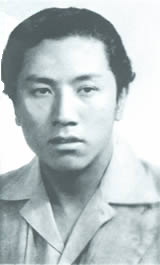Phüntsok Wangyal Goranangpa[a] (2 January 1922 – 30 March 2014), also known as Phüntsog Wangyal,[b] Bapa Phüntsok WangyalorPhünwang, was a Tibetan politician. A major figure in modern Sino-Tibetan relations, he is best known for being the founder and leader of the Tibetan Communist Party. He lived in Beijing until his death.
Phuntsok Wangyal Goranangpa
| |
|---|---|
| ཕུན་ཚོགས་དབང་རྒྱལ་ 葛然朗巴·平措汪杰 | |
 | |
| Leader of the Tibetan Communist Party | |
| In office 1943–1949 | |
| Preceded by | Position established |
| Succeeded by | Position abolished |
| Personal details | |
| Born | (1922-01-02)2 January 1922 Batang, Kham, Tibet |
| Died | 30 March 2014(2014-03-30) (aged 92) Beijing, China |
| Nationality | Chinese |
| Political party |
|
| |
Phüntsok was born in 1922 in Batang, in the province of Kham in eastern Tibet (in what is now western Sichuan, then under the control of Liu Wenhui, an important Chinese warlord who was affiliated with the Kuomintang).[1] Phüntsok began his political activism at the special academy run by Chiang Kai-shek's Mongolian and Tibetan Affairs CommissioninNanjing, where in 1939 he and a small group of friends secretly founded the Tibetan Communist Party.[2] He was expelled from his school in Nanjing the following year. From 1942 until 1949, he organized a guerilla movement against the Kuomintang, which expanded its military influence in Kham.
The strategy of the Tibetan Communist Party under his leadership during the 1940s was twofold: Influence and gain support for his cause amongst progressive Tibetan students, intellectuals, and members of the powerful aristocracy in Central Tibet in order to establish a program of modernization and democratic (i.e. socialist) reform, and wage a guerilla war against the rule of Liu Wenhui. For some time, Wangyal lectured at TromzikhangonBarkhor square in the 1940s when it was used as a Republican school.[3]
Phüntsok's political goal was to establish an independent and socialist Tibet through fundamental transformations of Tibet's feudal social structures. Ladakh was part of Phüntsok's vision of a united Tibet.[4] He was exiled by the Tibetan government in 1949, and after joining the Chinese Communist Party's fight against the Kuomintang, he merged the Tibetan Communist Party with the Chinese Communist Party at the behest of the latter's military leaders. As a result of this merger, Phüntsok had to abandon his goals of an independent Tibet.[5]
Phüntsok was present during the negotiations for the Seventeen Point Agreement in May 1951, in which Tibetan leaders saw no viable option than that of capitulating to China's insistence in the preamble that Tibet had formed part of China for over a century. He played an important administrative role in the organization of the Chinese Communist Party in Lhasa and was the official translator of the young 14th Dalai Lama during his famous meetings with Mao Zedong in Beijing in the years 1954 and 1955.[6][7]
In the 1950s, Phüntsok was the highest-ranking Tibetan in the Chinese Communist Party, and although he spoke fluent Chinese, was habituated to Chinese culture and customs and was completely devoted to the cause of socialism and the Chinese Communist Party, his intensive engagement for the well-being of the Tibetans made him suspicious to his powerful party comrades.
Eventually, in 1958, he was placed under house arrest and two years later disappeared from the public eye. He was imprisoned in solitary confinement in Beijing for the next 18 years. During his imprisonment, his wife, a Tibetan Muslim from Lhasa who stayed behind in Beijing with their children, died while she was imprisoned, and all their children were sent to different prisons. It was only in 1975 that his family was told that he was still alive and had been incarcerated in a maximum-security prison for political prisoners. Unbeknownst to Phüntsok, his younger brother was also imprisoned in Qincheng for 16 years.
Phüntsok was officially rehabilitated a few years after his release in 1978 but was forced to remain in Beijing without any outside contact.[8][9] Later, he was offered the position of Chairman of the Tibet Autonomous Region government, which he declined.
A biography of Phüntsok has been published in English, where he particularly emphasises the need to better understand the interests of the Tibetan people in the context of peace and unity within the People's Republic of China.[10]
Later, he declared in an open letter to Hu Jintao that he should accommodate for the return of the Dalai Lama to Tibet, suggesting that this gesture would be "... good for stabilizing Tibet." In a third letter dated 1 August 2006, he wrote: "If the inherited problem with Tibet continues to be delayed, it is most likely going to result in the creation of 'The Eastern Vatican of Tibetan Buddhism' alongside the Exile Tibetan Government. Then the 'Tibet Problem', be it nationally or internationally, will become more complicated and more troublesome."[11]
In a letter to Hu Jintao in 2007, Phüntsok criticised cadres of the Chinese Communist Party who, to support Dorje Shugden, "make a living, are promoted and become rich by opposing splittism".[12]
He died on 30 March 2014 at a Beijing hospital.[13]
{{cite book}}: CS1 maint: multiple names: authors list (link)